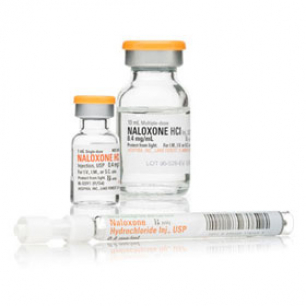In recognition of International Overdose Awareness Day on Saturday, 31 August 2019 NDARC’s Dr Amy Peacock and Dr Sarah Larney share some key information about naloxone.
What is naloxone?
Naloxone (also known as Narcan®) is an opioid antagonist that is a safe and effective agent for reversing the effects of opioids, including pharmaceutical opioids (e.g. methadone, codeine, fentanyl and morphine) and illicit opioids (e.g. heroin).
What is an overdose?
The brain has many receptors for opioids. An overdose occurs when a person consumes too much of an opioid, meaning that the opioid binds to too many of these receptors. As a consequence, breathing may slow and then stop.
How does naloxone work?
Naloxone is an opioid antagonist, which means it lodges in opioid receptors in the brain but does not given an opioid effect. Naloxone ‘clears’ the opioid receptors temporarily, overriding the effects of any opioids that have been taken. This allows a person who has overdosed to breathe again, reversing the effects of the overdose.
Naloxone can be administered as an intramuscular injection or nasal spray.
In responding to an overdose, people should:
- Check that there is no surrounding danger
- Check for signs of an overdose:
- Not responding to questions/movement (e.g. shaking)
- Difficulty breathing
- Pale or cold skin
- Blue lips
- Small pupils
- Call an ambulance (ring 000) for help
- Clear airways and provide rescue breathing
- Assemble a naloxone kit and either inject naloxone into the muscle of the upper arm or outer thigh, and repeat injections every two to three minutes as needed
- Stay with the person until an ambulance arrives
What are the risks of giving someone naloxone?
Naloxone has been shown to be a safe drug. It has no effects other than reversing overdose and does not produce intoxication, nor is there a risk of developing dependence.
It is important to note that a person with opioid dependence could experience withdrawal symptoms (e.g. nausea, vomiting, sweating) when given naloxone to reverse an overdose.
It is very important that a person who has been given naloxone understands that using opioids immediately after may lead to another overdose when the naloxone wears off.
Naloxone stays in the body for a short period of time (between one and one and a half hours) while opioids stay in the body for many hours, so a person could be at risk of another overdose if they consume more opioids.
Who can use naloxone?
Naloxone was traditionally administered by emergency personnel, like paramedics.
Now, anyone who witnesses an overdose can administer naloxone (friends, family, bystanders etc.) with minimal training. There’s strong evidence to suggest that naloxone can be used safely by people who are not medical professionals
Where is naloxone available?
As of 1 February 2016, naloxone can be purchased over the counter in Australian pharmacies. Ask your pharmacist for naloxone as it may need to be ordered.
Take-home naloxone training programs are also available and operate from many services that provide care for people who use drugs.
Why is naloxone important?
Nearly 2,000 people in Australia died directly because of opioids in 2017. These deaths are mostly accidental. They are also preventable. For more information read the Drug Trends bulletin: Trends in Drug-Induced Deaths in Australia, 1997-2017.
We need to ensure that people who are at risk of overdose – and their friends and families – have access to naloxone so that the risk of loss of life from opioids is reduced.
Further reading
This open access paper provides further information about the use of naloxone for opioid overdose: Take-Home Naloxone for the Emergency Interim Management of Opioid Overdose: The Public Health Application of an Emergency Medicine.
International Overdose Awareness Day
International Overdose Awareness Day aims to raise awareness of overdose and reduce the stigma of a drug-related death. It is also an opportunity to stimulate discussion about evidence-based overdose prevention and drug policy. Click here to read more about International Overdose Awareness Day.
Stop Overdose Safely (S-O-S) Initiative
In 2017, the United Nations Office on Drugs and Crime (UNODC) and World Health Organization (WHO) launched the Stop Overdose Safely (S-O-S) Initiative. The S-O-S Initiative aims to save lives by promoting access to naloxone and the training of potential first responders in overdose management. Click here to read more about the S-O-S Initiative.
If you think someone is experiencing an overdose, please call 000.
For free and confidential advice about alcohol and other drugs call the National Alcohol and Other Drug Hotline - 1800 250 015.




